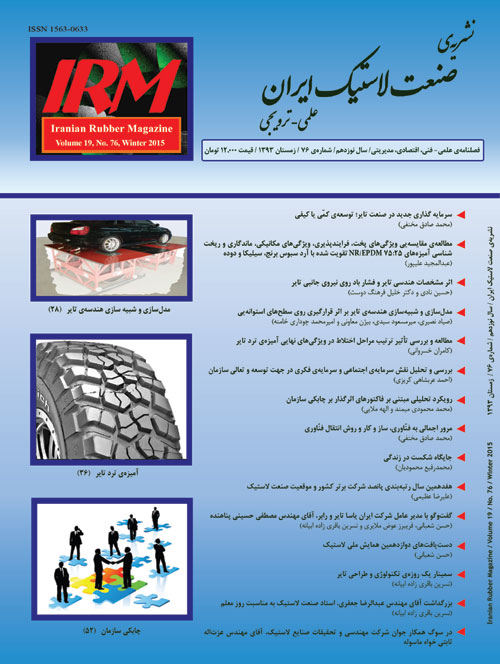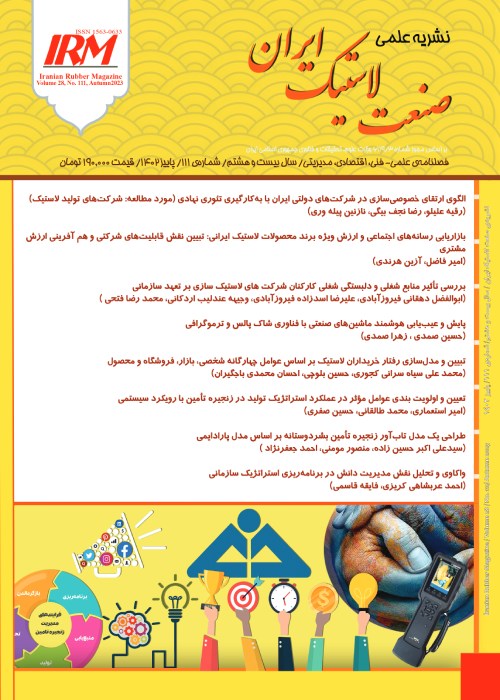فهرست مطالب

نشریه صنعت لاستیک ایران
پیاپی 76 (زمستان 1393)
- تاریخ انتشار: 1393/11/28
- تعداد عناوین: 14
-
- سرمقاله
- علمی فنی
- مدیریت
- دیدگاه
-
صفحه 67
- گفت و گو
- گزارش
-
Page 4The performance of rice husk ash (RHA), obtained by burning rice husks, as a filler for natural rubber (NR)/ethylene–propylene–diene monomer (EPDM) blends was investigated. For comparison purposes, two commercial reinforcing fillers, silica and carbon black were also used. A fixed 75: 25 blend ratio (wt %) of NR and EPDM was prepared using a two stage conventional mixing procedure. Filler loading was varied from 0 to 60 parts per hundred of resin (phr) at 15 phr intervals. The results indicated that RHA offers processing advantages over silica and carbon black. The use of RHA as an additional filler provided almost no improvement in the tensile strength and abrasion resistance of the 75: 25 NR/EPDM blends. The ozone resistance of the blends was inferior to those obtained from the addition of RHA. However, RHA was better in resilience property than that of silica and carbon black. Scanning electron micrographs revealed that the dispersion of RHA filler in the rubber matrix is discontinuous, which in turn generates weak structure when compared with carbon black and silica. According to these observations, RHA could be used as a diluent filler for the 75: 25 NR/EPDM blend, while silica and carbon black can be used as a reinforcing filler.Keywords: Natural rubber, EPDM, blend, rice husk ash, silica, carbon black, filler
-
Page 17The performance specifications of vehicles on the road are the result of dynamic interaction of various components of the vehicle structure. But the car tire because it is directly in contact with the road surface and plays an important role. Indeed the tire is the generator of the forces and moments which control vehicle motion. However the tire’s structure is relatively complex but defining specific parameters can simplify modeling the behavior of complexity of the structure and behavior of the tire is too comprehensive so that ever theory that could answer many questions in predicting tire performance is not provided. Theories presented by embellishment from relations or parameters that are obtained through empirical-rather than mathematical analysis and physical-are mixed. Here our purpose to describe the effect of the geometry of the tire and the inflated pressure on the tire side force which plays an essential role in the tire dynamic behavior.Keywords: Side force, Tire stiffness coefficient, Slip angle, Camber angle, Slip ratio
-
Page 28This paper studies the change of tire geometry placed on cylindrical surfaces (drums) with different diameters. The change of intended geometry includes contact patch of tire and drum and vertical displacement of tire center. Furthermore, the result of simulation of placing tire on a flat surface is compared with an actual test. The relationship between area of contact patch and diameter of drum and exerted load on tire has been obtained. Finally, the appropriate diameter of drum for road simulating test stand has been proposed.Keywords: Tire, drum, geometry modification, braking test stand, simulation
-
Page 36We can improve mechanical properties of polymeric compounds with change of mixing cycles in internal mixers. In this study we report results of tests on truck tread compounds. This improvements occurs without any change in mixing costs.Keywords: Tread, Interaction, Flex cracking resistance
-
Page 40Efficiency, effectiveness and productivity are important goals of the organization. Organizations to achieve their goals, try to make optimum use of available resources. While some managers are not aware of the organization’s assets. In this paper three major categories: social capital, intellectual capital, excellence and relationships between them were explained. Conceptual and empirical definition of social capital initially proposed. Then a few social theorists and their theories were introduced briefly. To better understand the concept of social capital, social capital elements (including trust and links) were discussed. In the next step we are familiar with the concept of intellectual capital and its various definitions. In order to become more familiar with the concept of intellectual capital, intellectual capital elements (including: human capital, structural capital and relational capital), classification of intellectual capital and measurement methods were studied. In the next part of the paper, the necessity and importance of intellectual capital and impact of intellectual capital management on organizational performance were discussed. Finally, functions of social capital and the relationship between economic development and social capital were examined. In today’s dynamic circumstances, organizations must be able to effectively utilize their funds. In this paper, the necessity and importance of intellectual and social capital and their roles role in the perfection and excellence were discussed.Keywords: Social Capital, Intellectual Capital, Growth, Development, Excellence
-
Page 54In this turbulent world, the only thing which does not change is the change itself. In the business world which is directed increasingly under the three terms of customer, competition and change, organizations are trying to find the solutions for their problems. In the past decade, most companies adapted restructuring and re-engineering in response to environment challenges and demands, but nowadays the old approaches and solutions have lost their competency to deal with the organizational challenges and they are better to get replaced with new methods. The best and newest way of survival and success of the organizations is focusing on their organizational agility. The organizational agility is a wisely and complete response to the rapidly changing requirements in competitive markets and succeeding by the opportunities the organization gets. The aim of current research is to study the effective factors on organizational agility. Many researchers have classified these factors under three sections including drivers, capabilities and enablers of the agility. With reference to this approach, the paper has presented some conceptions of agility at the beginning and a brief history of it. Then, drivers, capabilities and enablers have been introduced with imparting different theories and models. It is expected that this research would be able to accelerate the organizations getting success and helping the future researchers.Keywords: Agility, Drivers, Capabilities, Enablers


